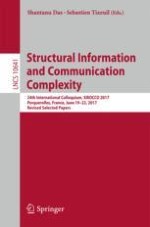This book constitutes the thoroughly refereed proceedings of the 24th International Colloquium on Structural Information and Communication Complexity, SIROCCO 2017, held in Porquerolles, France, in June 2017.
The 21 full papers presented were carefully reviewed and selected from 41 submissions. They are devoted to the study of the interplay between structural knowledge, communications, and computing in decentralized systems of multiple communicating entities. They are organized around the following topics: wireless networks; identifiers and labeling; mobile agents; probabilistic algorithms; computational complexity; dynamic networks.
